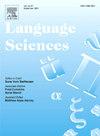雅加达印尼语口语化问题的认知标记
IF 1.1
2区 文学
Q2 EDUCATION & EDUCATIONAL RESEARCH
引用次数: 0
摘要
本研究旨在扩大我们对雅加达印尼语口语化标记题的认知标记的理解。本文以儿童语言数据交换系统(CHILDES)的数据为基础,重点研究了话语标记语“咚”在极性问题和内容问题中的使用。此外,本文还考察了“东”和“雅”在极性问句中的共现现象。标记语表明说话者认识到自己的知识有限,而听者在这件事上有更大的权威。此外,这表明说话者有意地提出他们的问题,因为他们在说话的那一刻重建了他们的理解。当“dong”和“ya”在极性疑问句中同时出现时,它反映了说话者邀请听者确认他们根据先验信息合成的结论。这种组合表明说话者对预设信息的承诺更强。本文章由计算机程序翻译,如有差异,请以英文原文为准。
The epistemic marking of questions in Colloquial Jakartan Indonesian
This study aims to expand our understanding of epistemic marking in marked questions in Colloquial Jakartan Indonesian. It focuses on the use of the discourse marker dong in both polar and content questions, based on data from the Child Language Data Exchange System (CHILDES). Additionally, it examines the co-occurrence of dong and ya in polar questions. The marker dong signals speakers' recognition of their own limited knowledge and the hearer's greater authority on the matter. Furthermore, it indicates that speakers intentionally present their questions as the result of reconstructing their understanding up to the moment of speaking. When dong co-occurs with ya in polar questions, it reflects the speakers' invitation for the hearers to confirm conclusions they have synthesized based on prior information. This combination suggests a stronger speaker commitment to the presupposed information.
求助全文
通过发布文献求助,成功后即可免费获取论文全文。
去求助
来源期刊

Language Sciences
Multiple-
CiteScore
2.90
自引率
0.00%
发文量
38
期刊介绍:
Language Sciences is a forum for debate, conducted so as to be of interest to the widest possible audience, on conceptual and theoretical issues in the various branches of general linguistics. The journal is also concerned with bringing to linguists attention current thinking about language within disciplines other than linguistics itself; relevant contributions from anthropologists, philosophers, psychologists and sociologists, among others, will be warmly received. In addition, the Editor is particularly keen to encourage the submission of essays on topics in the history and philosophy of language studies, and review articles discussing the import of significant recent works on language and linguistics.
 求助内容:
求助内容: 应助结果提醒方式:
应助结果提醒方式:


